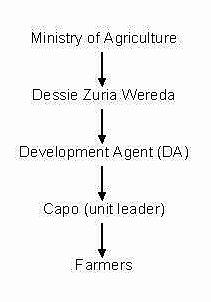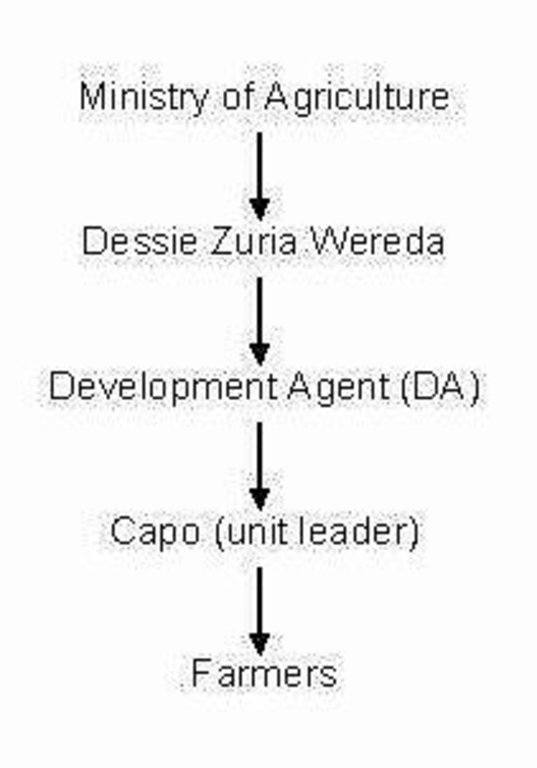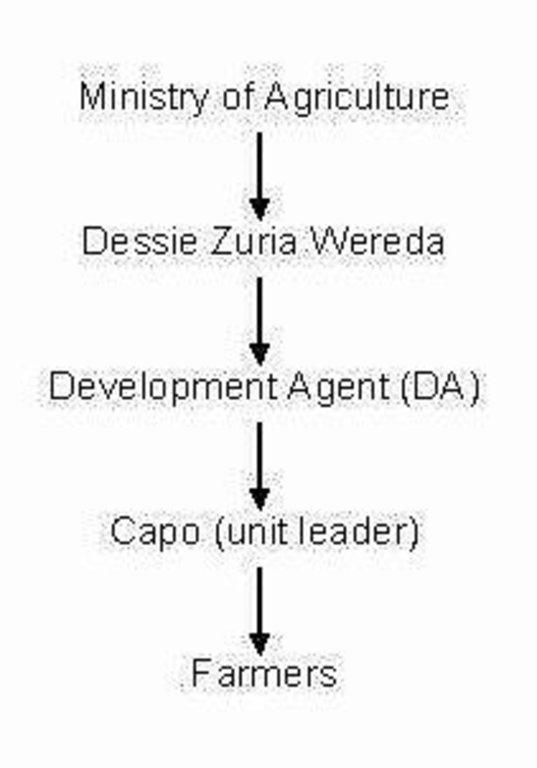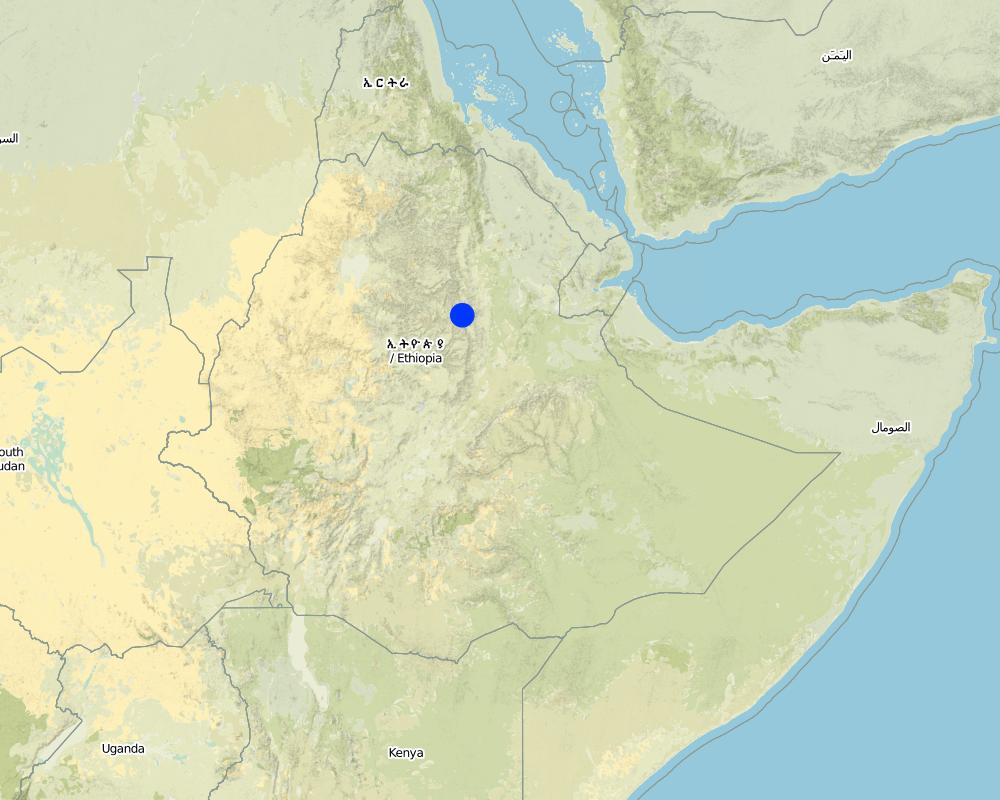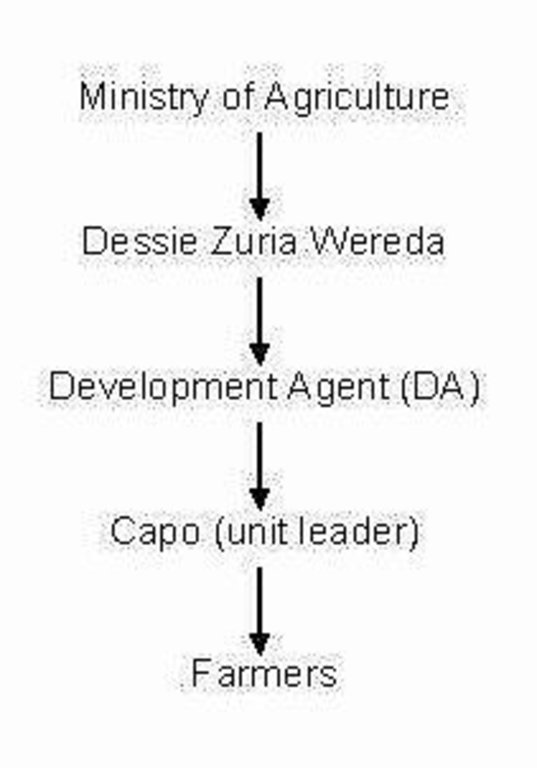food-for-work programm [Ethiopia]
- Creation:
- Update:
- Compiler: Sabina Erny
- Editor: –
- Reviewer: Fabian Ottiger
approaches_2554 - Ethiopia
View sections
Expand all Collapse all1. General information
1.2 Contact details of resource persons and institutions involved in the assessment and documentation of the Approach
1.3 Conditions regarding the use of data documented through WOCAT
The compiler and key resource person(s) accept the conditions regarding the use of data documented through WOCAT:
Ja
1.4 Reference(s) to Questionnaire(s) on SLM Technologies

level bund with double stone walls [Ethiopia]
level bund with double stone walls with soil and grass to stabilize the structure
- Compiler: Sabina Erny
2. Description of the SLM Approach
2.1 Short description of the Approach
food-for-work programm with distribution of grains and oil
2.2 Detailed description of the Approach
Detailed description of the Approach:
Aims / objectives: Overall purpose: contribute to the SWC of the area; Specific objectives: build the level bunds, reforestation and the cut-off drains
Methods: Incentives for work
Stages of implementation: Collect farmers, tell them about the conservation, they formed groups/units who worked under a unit leader (capo=chief)
Role of stakeholders: Farmers carried out the work, the construction of the level bunds, the planting of trees. The technician told them what to do. Passive role of the farmers.
Other important information: Discussion started after implementation when farmers came to eht research station to get advice what they could do about the narrow terraces on the steep steep slopes and against the rats. Together they found a solution.
2.3 Photos of the Approach
2.5 Country/ region/ locations where the Approach has been applied
Country:
Ethiopia
Region/ State/ Province:
South Wello
Map
×2.6 Dates of initiation and termination of the Approach
Indicate year of initiation:
1983
Year of termination (if Approach is no longer applied):
1985
2.7 Type of Approach
- project/ programme based
2.8 Main aims/ objectives of the Approach
The Approach focused mainly on SLM with other activities (1984 construction of water channel for water pump for an irrigation project (outside of described catchment, but affectsuing people within catchment as well), road from main road Dessie-Jemme-Borana down to lake was constructed through the same approach)
give food and get work for it; not just getting the food even though there was a drought, but the people received only food if they worked for it
The SLM Approach addressed the following problems: drought, to improve the field qualities, prevention of erosion, to give the hungry farmers food because they were suffering from shortage of food
2.9 Conditions enabling or hindering implementation of the Technology/ Technologies applied under the Approach
social/ cultural/ religious norms and values
- hindering
farmers were weak because of drought
Treatment through the SLM Approach: food helped because they got it every 2 weeks
availability/ access to financial resources and services
- hindering
time-consuming activities
Treatment through the SLM Approach: food-for-work
legal framework (land tenure, land and water use rights)
- enabling
The existing land ownership, land use rights / water rights helped a little the approach implementation
knowledge about SLM, access to technical support
- hindering
not enough material
Treatment through the SLM Approach: shovel, hoes lend to the farmers
3. Participation and roles of stakeholders involved
3.1 Stakeholders involved in the Approach and their roles
- local land users/ local communities
Working land users were mainly men (also some women)
The capo is a man; it is the culture and tradition that men work on the field, women collect stones; men dig lines, bring soil with the shovel, build stone walls
- national government (planners, decision-makers)
- international organization
If several stakeholders were involved, indicate lead agency:
Designed by SIDA
3.2 Involvement of local land users/ local communities in the different phases of the Approach
| Involvement of local land users/ local communities | Specify who was involved and describe activities | |
|---|---|---|
| initiation/ motivation | none | |
| planning | passive | information |
| implementation | external support | Mainly: casual labour; partly: responsibility for major steps; the capo has a greater responsibility |
| monitoring/ evaluation | none | |
| Research | passive | on-station |
3.3 Flow chart (if available)
3.4 Decision-making on the selection of SLM Technology/ Technologies
Specify who decided on the selection of the Technology/ Technologies to be implemented:
- SLM specialists alone
Explain:
Decisions on the method of implementing the SLM Technology were made by by SLM specialists alone (top-down)
4. Technical support, capacity building, and knowledge management
4.1 Capacity building/ training
Was training provided to land users/ other stakeholders?
Ja
Specify who was trained:
- land users
- SWC specialists
Form of training:
- demonstration areas
- public meetings
Subjects covered:
the cattle should not enter the cultivated land until bund is established; how to maintain the bunds was also demonstrated
4.2 Advisory service
Do land users have access to an advisory service?
Ja
Specify whether advisory service is provided:
- at permanent centres
Describe/ comments:
1) Advisory service was carried out through: projects own extension structure and agents; Extension staff: mainly government employees 2) Target groups for extension: land users
Advisory service is inadequate to ensure the continuation of land conservation activities; they need new, different technologies, another training to give to the people
4.3 Institution strengthening (organizational development)
Have institutions been established or strengthened through the Approach?
- no
4.4 Monitoring and evaluation
Is monitoring and evaluation part of the Approach?
Ja
Comments:
technical aspects were ad hoc monitored through observations
There were no changes in the Approach as a result of monitoring and evaluation
4.5 Research
Was research part of the Approach?
Ja
Specify topics:
- sociology
- ecology
Give further details and indicate who did the research:
it was especially undertaken for the environment
Research was carried out on station
5. Financing and external material support
5.1 Annual budget for the SLM component of the Approach
Comments (e.g. main sources of funding/ major donors):
Approach costs were met by the following donors: international non-government (WFP): 100.0%
5.2 Financial/ material support provided to land users
Did land users receive financial/ material support for implementing the Technology/ Technologies?
Ja
5.3 Subsidies for specific inputs (including labour)
- equipment
| Specify which inputs were subsidised | To which extent | Specify subsidies |
|---|---|---|
| tools | partly financed | Hand tools |
If labour by land users was a substantial input, was it:
- food-for-work
Comments:
grains and oil
5.4 Credit
Was credit provided under the Approach for SLM activities?
Nee
6. Impact analysis and concluding statements
6.1 Impacts of the Approach
Did the Approach help land users to implement and maintain SLM Technologies?
- No
- Yes, little
- Yes, moderately
- Yes, greatly
terraces
Did other land users / projects adopt the Approach?
- No
- Yes, little
- Yes, moderately
- Yes, greatly
6.3 Sustainability of Approach activities
Can the land users sustain what has been implemented through the Approach (without external support)?
- uncertain
If no or uncertain, specify and comment:
only some of them can because it needs lots of labor and time
6.4 Strengths/ advantages of the Approach
| Strengths/ advantages/ opportunities in the land user’s view |
|---|
| incentives are good to start the project (How to sustain/ enhance this strength: give food, material) |
| they learned a lot from the project (How to sustain/ enhance this strength: give them more information, train them) |
| they were happy to get some food |
| Strengths/ advantages/ opportunities in the compiler’s or other key resource person’s view |
|---|
| pass on information, trainings (How to sustain/ enhance this strength: give more information and trainings) |
6.5 Weaknesses/ disadvantages of the Approach and ways of overcoming them
| Weaknesses/ disadvantages/ risks in the land user’s view | How can they be overcome? |
|---|---|
| payment was fixed, but because of the drought, the farmers were too weak to work | payment should be flexible |
| top-down | more bottom-up |
| Weaknesses/ disadvantages/ risks in the compiler’s or other key resource person’s view | How can they be overcome? |
|---|---|
| not having asked the farmers; top-down approach | involve farmers from the beginning, so they feel needed and useful |
| local knowledge has not been considered | ask the farmers and integrate their knowledge |
| incentive food should be reconsidered especially because it was not flexible and there was a drought and they strictly distributed it according to their measures and not according to the situation | no strict calulation formula of the food, so there is space to give more food if needed as it would have been the case here since there was a serious drought at the stage of implementation |
7. References and links
7.1 Methods/ sources of information
- field visits, field surveys
- interviews with land users
Links and modules
Expand all Collapse allLinks

level bund with double stone walls [Ethiopia]
level bund with double stone walls with soil and grass to stabilize the structure
- Compiler: Sabina Erny
Modules
No modules


